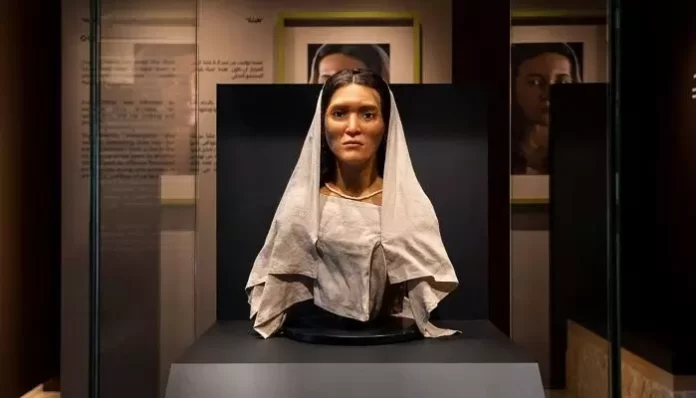After years of research and analysis, Saudi Arabia has unveiled the reconstructed face of a 2000-year-old Nabataean woman using cutting-edge 3D printing technology. The woman, named Hinat, was discovered in a tomb in Hegra, a UNESCO World Heritage Site in AlUla, an ancient oasis city in northwestern Saudi Arabia.
Unveiling the Reconstruction
The reconstructed face of Hinat was put on display at the Hegra Welcome Center in AlUla, allowing visitors to see the first-of-its-kind digital reconstruction. The face was made from silicon, with pierced ears and artificial hair individually threaded into her scalp. The reconstructed face is an attempt to learn more about the Nabataean civilization, which inhabited northern Arabia more than 2000 years ago.
The Process of Reconstruction
To reconstruct Hinat’s face, a team of experts used 3D printing technology to rebuild bone fragments found in the tomb. Forensic artists used a CT scan to make a 3D model of the skull, which was then used to sculpt the face of the woman.
The project to reconstruct the face began in the UK in 2019 and was funded by the Royal Commission. The reconstructed face is made of silicon and has pierced ears and artificial hair that was individually threaded into her scalp.
The Nabataean Civilization and its Mystery
The Nabataeans were an ancient Semitic people who inhabited northern Arabia over 2,000 years ago. Petra was the capital of their kingdom, which became a trading hub for spices, medicine, and fabric. Despite being a significant part of history, the Nabataeans are still somewhat of a mystery. They did not leave behind any literary texts or records, leaving historians and archaeologists with limited information about their lives and customs.
Laila Nehme, the Lebanese-French archaeologist and director of the project, stated in an interview with National Geographic, “The Nabataeans are a bit of a mystery: We know a lot, but at the same time, we know very little because they didn’t leave any literary texts or records.”
Creative Liberties and Scientific Interpretations
As there are limited records of the Nabataean people, researchers had to take creative liberties in reconstructing Hinat’s face. Some of the characteristics of the woman were determined by historical archaeological data, in addition to the remains found in the tomb. Due to this, some archaeologists have questioned the accuracy of the reconstruction, claiming that more data and scientific interpretations are lacking in facial approximation, according to the Live Science website. However, the project’s lead archaeologist, Laila Nehme, sees the reconstruction as a wonderful opportunity to learn more about their idea of the afterlife.
“It tells us Hegra wasn’t just a place of tombs, but a vibrant place where people lived and worked and died. It’s lovely to be reminded,”
said Leila Chapman, a representative from the Royal Commission for AlUla.
The remains of Hinat were found in 2015 along with 80 other skeletons. She was believed to have died in her 40s to 50s and had an “average social status.” The woman received the name Hinat due to inscriptions found on her tomb.
The Nabataean civilization was a people who lived on the ancient Frankincense Trade Route, which connected southern Arabia to the Mediterranean, making the Nabataean people stand out in international trade around the 6th century BCE. Despite their importance in trade, the Nabataean civilization remains a mystery, with little known about their daily lives and customs.
Advancements in 3D Printing Technology
The unveiling of Hinat’s reconstructed face is a significant milestone for archaeologists and historians alike. It provides a rare glimpse into the lives of the Nabataean people, who left behind no written or genetic records. With advancements in technology, there is hope that more insights into ancient civilizations can be uncovered, giving us a better understanding of our shared human history.
With 3D printing, experts can create models of historical artifacts and remains that are more accurate and detailed than ever before. This technology allows historians and archaeologists to learn more about past civilizations and customs and provides insights into the daily lives of people who lived centuries ago. As 3D printing technology continues to improve, there will undoubtedly be more exciting discoveries and insights made in the field of archaeology.



